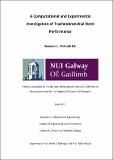| dc.contributor.advisor | McHugh, Peter | |
| dc.contributor.advisor | Bruzzi, Mark | |
| dc.contributor.author | McGrath, Donnacha John | |
| dc.date.accessioned | 2017-11-07T09:58:43Z | |
| dc.date.issued | 2017-05-25 | |
| dc.identifier.uri | http://hdl.handle.net/10379/6951 | |
| dc.description.abstract | Tracheobronchial stents are used to relieve blockages in the respiratory tree, typically caused by lung cancer. However, multiple complications can be associated with stents for this indication. In order to be able to improve clinical outcomes, a better understanding of device behaviour must be obtained. The work performed in this thesis investigates the mechanical performance of tracheobronchial stents under in-vitro and in-vivo conditions, and develops an experimental and computational framework from which future designs may be investigated and improved.
The mechanical performance of bare laser-cut nitinol stents is first investigated through a detailed study on the effect of device geometry and material properties on stent response. It is shown that the non-linear properties of nitinol can have a significant effect on stent stability which should be accounted for during the stent design process. An experimental and computational in-vitro testing methodology is then generated to determine the mechanical performance of bare and covered tracheobronchial stents. Through this analysis it is shown that stent response is highly loading specific, suggesting that the loading configuration that a stent is about to be subjected to should be considered pre-implantation.
Ovine lung deformation models are developed to evaluate stent response in physiologically realistic conditions. The generated models account for airway deformation due to a combination of lung motion and pressure loading. It is found that pressure conditions account for the majority of stent loading, but airway deformation due to lung motion can have an appreciable effect on stent mechanical response. Predictions from derived physiological stent deployment models are then compared to ovine pre-clinical implantation outcomes. Results of this suggest that granulation formation may be as a result of high levels of contact associated with lung motion. Indications of other common stent related complications are also highlighted in the models.
In conclusion, the work performed in this thesis has led to an enhanced understanding of the mechanical performance of tracheobronchial stents. The computational models and experimental tests generated in this work form a framework that could be used as an aid for improving tracheobronchial stent design. | en_IE |
| dc.rights | Attribution-NonCommercial-NoDerivs 3.0 Ireland | |
| dc.rights.uri | https://creativecommons.org/licenses/by-nc-nd/3.0/ie/ | |
| dc.subject | Biomedical engineering | en_IE |
| dc.subject | Finite element | en_IE |
| dc.subject | Nitinol stent | en_IE |
| dc.subject | Tracheobronchial | en_IE |
| dc.subject | Biomechanics | en_IE |
| dc.title | A computational and experimental investigation of tracheobronchial stent performance | en_IE |
| dc.type | Thesis | en_IE |
| dc.contributor.funder | European Union's Seventh Framework Programme | en_IE |
| dc.contributor.funder | College of Engineering and Informatics at NUI Galway | en_IE |
| dc.contributor.funder | Structured PhD Programme in Biomedical Engineering and Regenerative Medicine (BMERM) | en_IE |
| dc.local.note | Tracheobronchial stents are used to relieve blockages in the airways. However, these devices are associated with a number of complications. The work performed in this thesis investigates the mechanical performance of tracheobronchial stents, and develops an experimental and computational framework from which future designs may be investigated and improved. | en_IE |
| dc.description.embargo | 2019-04-13 | |
| dc.local.final | Yes | en_IE |
| nui.item.downloads | 1000 | |


